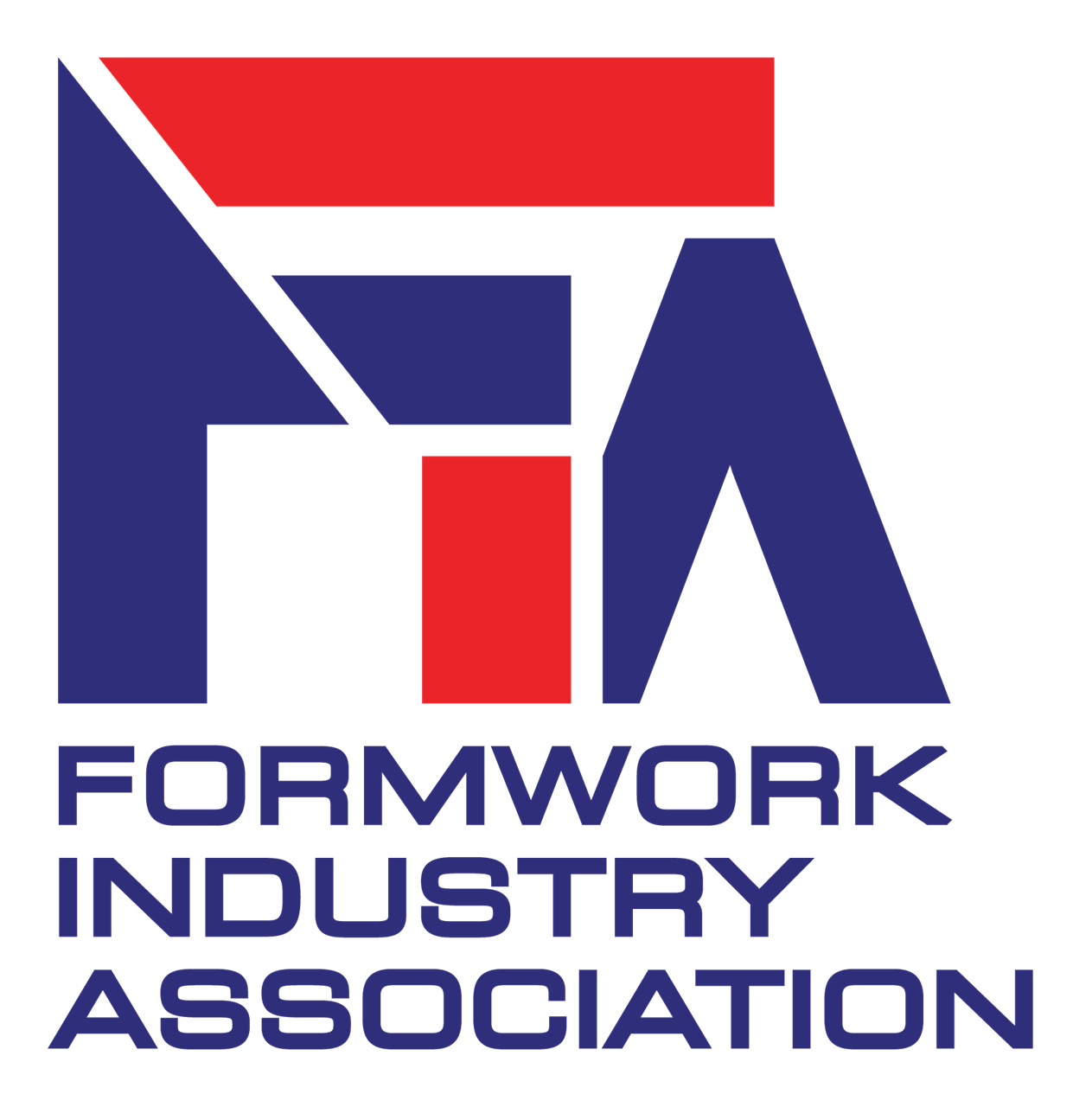Concrete pump delivery pipeline end fittings
Issued: 12/01/2021
Last Updated: 12/01/2021
Purpose
This safety alert highlights the risk of concrete pump delivery pipeline hose ends failing.
Businesses that fit end fittings to concrete delivery hoses and pipes should follow and document sound engineering practices and provide information on inspection methods to customers.
Concrete pump owners should obtain information from suppliers of pipes and hoses on the manufacturing methods used and appropriate inspection methods.
Background
There have been incidents in Queensland where the ends of both rubber and steel concrete delivery lines have failed and sprayed concrete under pressure.
Failures included a:
- swaged ferrule cracking with the end breaking away (refer Photograph 1)
- ferrule starting to separate from the rubber hose (refer Photograph 2) with the concrete spraying out of the gap
- flange cracking and breaking away from a steel 90-degree, 6-inch to 5-inch reducer bend, located at the hopper (refer Photographs 3 and 4).
Concrete pumping pressure can be in excess of 85 bar, especially when blockages occur. All of these incidents had the potential for serious injuries if workers had been near to where the failure occurred. In one incident, a car’s windscreen was broken approximately 15 metres away.
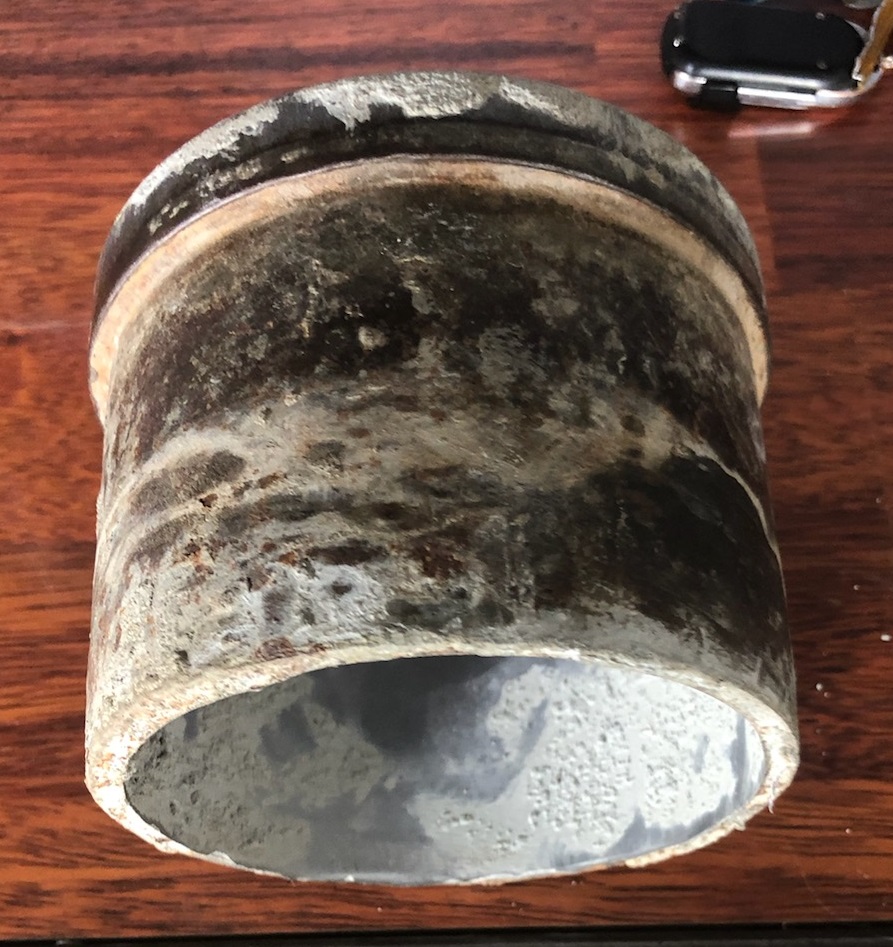
Photograph 1: Cracked and failed part of a swaged ferrule

Photograph 2: Ferrule that has separated from the hose.
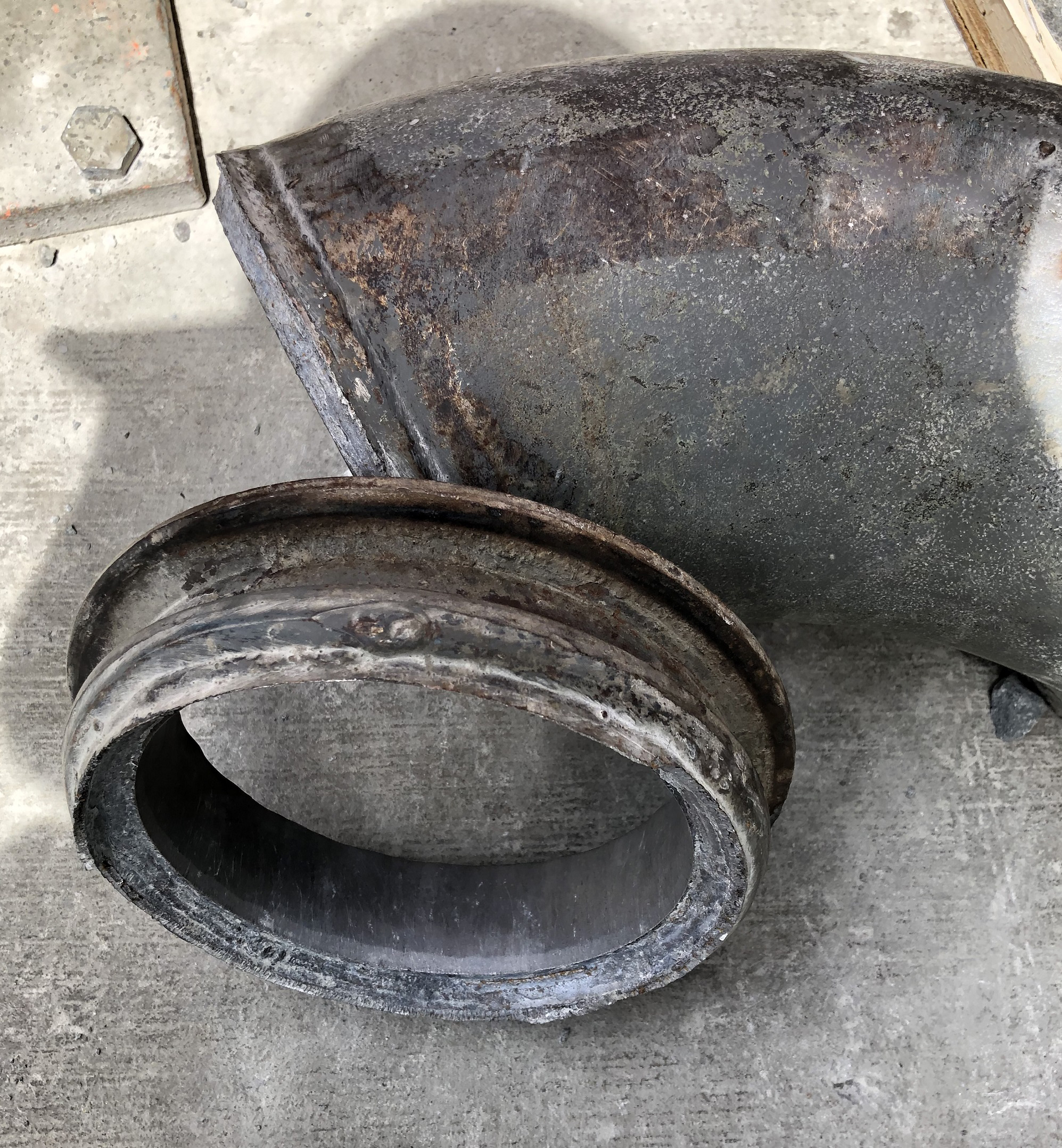
Photograph 3: Failed flange on steel reducer bend.
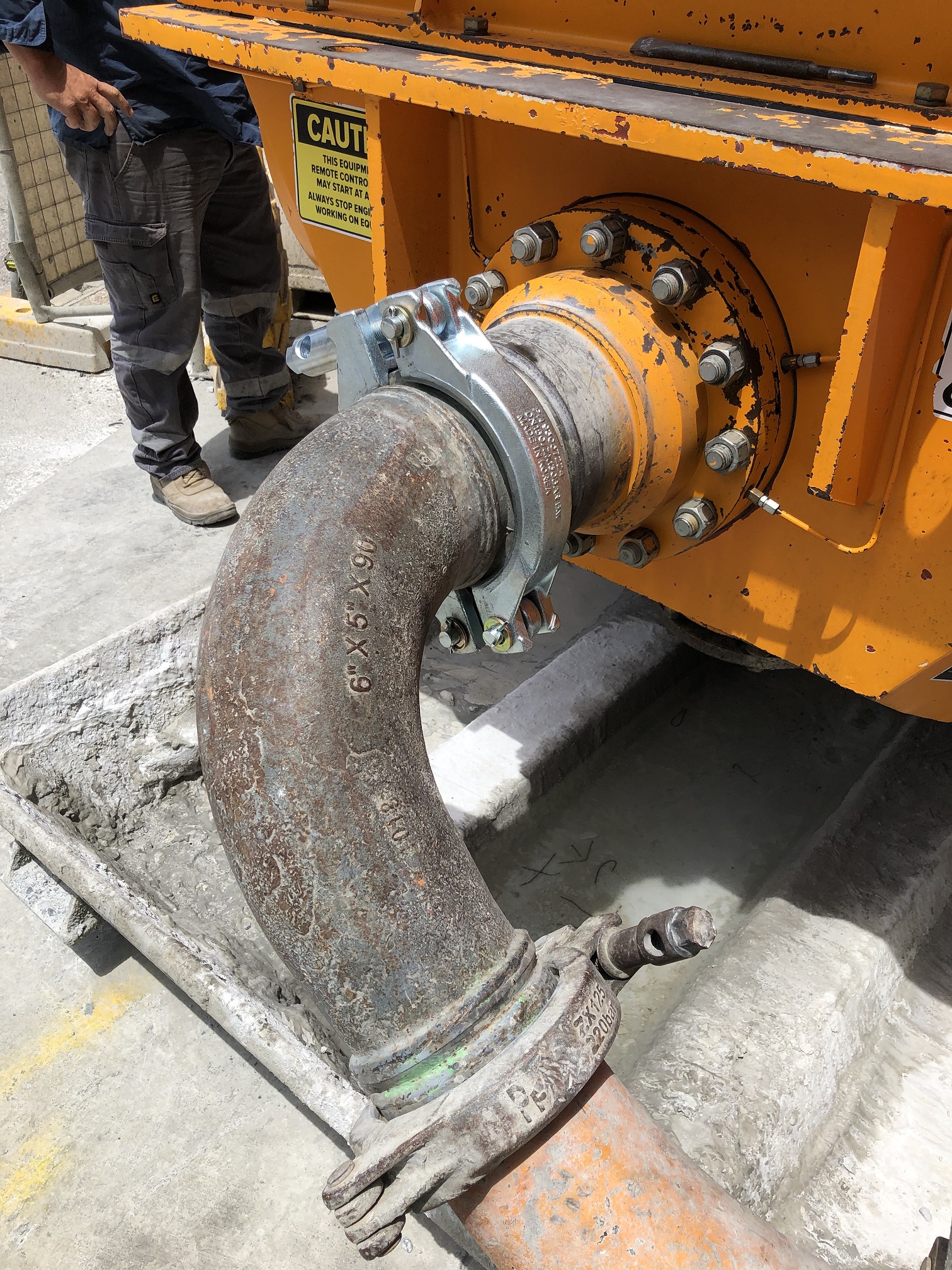
Photograph 4: Location of steel reducer bend.
Contributing factors
Swaged ferrules can fail due to:
- incorrect tolerances on the external and internal parts of the ferrules
- inadequate swaging force so that the dies do not contact one another during swaging
- incorrect specifications for the rubber hose
- incorrect material specifications for the inner and outer parts of the ferrule
- excessive wear—especially on the internal part of the fitting from concrete flow.
Photograph 5 shows an example of a swaged ferrule on a rubber hose where the indentations from the swaging method can be clearly identified. Swaging marks cannot be identified on the end fitting shown in Photograph 2.
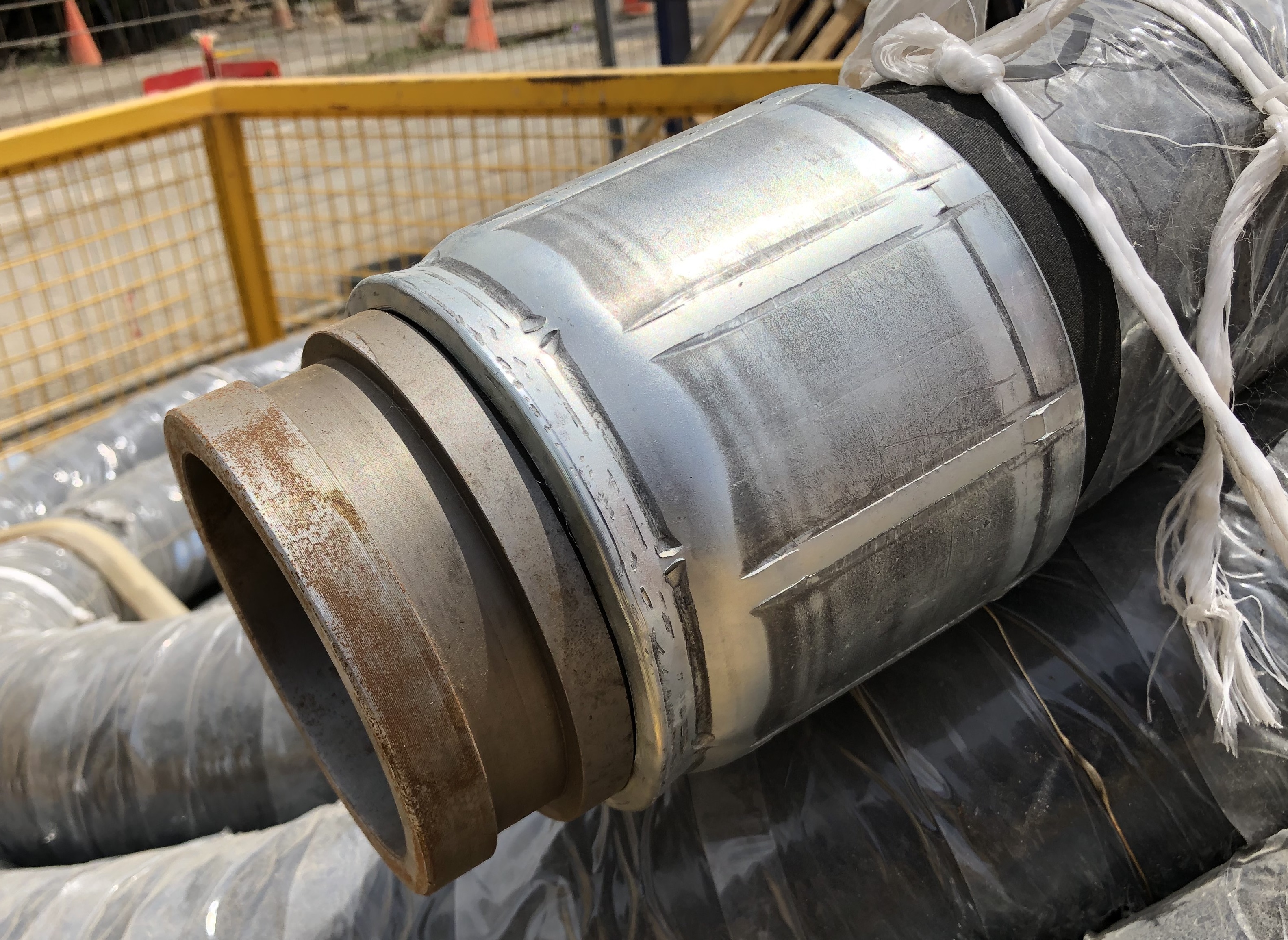
Photograph 5 – Swaged ferrule clearly showing swaging indentations.
Flanges on steel pipes can fail due to:
- poor welding due to incorrect electrodes, incorrect preparation, lack of penetration, or other welding irregularities
- flanges and pipes being made from steel types that can be difficult to weld
- poor matching of flanges to pipes (i.e. the flange doesn’t fit well on the pipe end)
- mishandling of the pipe flange (i.e. bashing the flange or pipe with a hammer when the adjacent pipe and/or hose clamp isn’t aligned)
- poorly fitting hose clamps (e.g. incorrect size, concrete build up).
Action required
Concrete pump owners
Concrete pump owners must take reasonable steps to ensure that a quality assurance program is followed while attaching the end fittings so that failure of the end fittings is avoided. It is generally easier to obtain certification from a local supplier when purchasing equipment.
If a concrete pump owner imports components from overseas, it may be more difficult to obtain trustworthy information on the manufacturing process. This is the case when the overseas supplier is unknown or there is no manufacturer’s mark. Unscrupulous manufacturers have also been known to copy manufacturers’ names and trademarks, so marking of products alone may not provide adequate evidence that the product is fit for purpose.
A concrete pump owner who imports equipment from overseas takes on the duties of an importer under the Work Health and Safety Act 2011. The importer must carry out, or arrange to have carried out, any calculations, analysis, testing, or examination of the equipment to control safety risks.
Suppliers of pipes and hoses
Suppliers of hoses and pipes with end fittings should ensure a quality assurance program is followed while attaching the end fittings and that information on this program is available for the purchaser.
Suppliers should also provide documented instructions on the operating parameters of the product along with inspection methods to be used.
If the supplier attaches end fittings to pipes or hoses, the supplier takes on the duties for manufacturers under the Work Health and Safety Act 2011 in addition to those duties for suppliers.
Fitting swaged ferrules to hoses
The same principles apply to fitting swaged ferrules to rubber hoses that apply to swaged ferrules on hydraulic hoses.
The following should be ensured:
- Comply with all of the conditions specified by the hose and/or ferrule manufacturer.
- The hose material and dimensions are suitable for concrete pumping and for fitting of swaged ferrules.
- The size of the external and internal parts of the ferrules must be within the tolerances specified by the hose manufacturer or ferrule manufacturer for the dimensions of the hose used.
- The swaging method and dies must comply with the specifications of the ferrule manufacturer (information from the hose manufacturer may also be needed).
Testing of the swaged ferrule is one way to help demonstrate the integrity of the connection. Proof testing of all ferrules or destructive testing of samples are methods that can be used. If proof testing is carried out, the test method needs to ensure the ferrule and hose are not damaged.
If there is any doubt about the manufacturing criteria or testing relating to the fitting of swaged ferrules, the advice of a suitably qualified professional engineer should be obtained.
Documented information on the swaging method should be maintained by the business carrying out the swaging. It is also advisable for the swaged ferrule to be permanently marked with a batch number or date so that any faulty batches can be easily isolated.
Welding flanges to steel pipe
Welding flanges to steel piping used for concrete pumping is a complex issue and requires high levels of technical input and skill to ensure the welding process will result in a quality product.
The following should be ensured:
- Only pipe specifically intended for concrete pumping should be used. Prior to welding, there should be some reliable method of verifying that the pipe and flanges are the actual type ordered.
- The weld specifications are to be compatible for the pipe and flange material characteristics and pressure specifications of the pipe being welded. Information should be obtained from the pipe manufacturer on this issue.
- Welding should be in accordance with a detailed weld procedure that includes electrode selection, pre-heating instructions (where required) and the use of a welding method that is recommended by the pipe manufacturer.
- Carrying out destructive testing on a test sample to verify the welding method is fit for purpose.
Inspection of hoses and pipes
All operators of concrete pumping equipment need to carry out ongoing inspection of pipes and hoses. Inspection methods and intervals for measuring pipe thickness is outlined in the Concrete Pumping Code of Practice 2019. However, in addition, an inspection program should be applied to rubber hoses, swaged ferrules on these hoses and flanges on steel pipes.
Inspection of hoses
Documented information on inspection of hoses should be provided by the business who fits the swaged ferrules, and this should be passed on by the hose supplier to the end user.
Hose suppliers should provide information on the maximum recommended volume of concrete that can be pumped before the hose is discarded. This will assist the pump owner in deciding when to carry out more intensive inspection of the hose and end fittings.
The inspection program should include an inspection before use and a periodical inspection with the interval based on the frequency of use and the operating environment.
The inspection program should include:
- an internal inspection with sufficient light levels checking hose tubes are of reasonable thickness, there is no textile fabric or steel reinforcing exposed, there are no blockages, rips, cuts or tears of the liner tube, and there are no collapsed sections of the inner tube or hose
- an external inspection checking for cover damage including cuts, tears, abrasion exposing the reinforcing material, chemical attack, kinks or collapsed areas, soft spots, cracking or weathering
- inspection of end fittings (including ferrules) for excessive wear and thinning of the wall thickness
- visual inspection of end fittings for cracks. If there’s any doubt or there is a history of cracking, non-destructive examination may be required
- checking swaged ends are intact and not slipping from the hose due to old age or from mechanical pulling loads.
Inspecting welded flanges on steel pipe
In addition to thickness testing of steel pipeline (specified in the Code of practice) and checking the pipeline for damage, it is important to check flanges on concrete pumping pipe.
The inspection program should include inspection of:
- welds for cracks, missing weld, weld undercut and weld consistency
- flanges to check they are not deformed and do not have hammer marks
- pipe ends internally for uneven wear and cracking
- flanges to ensure they are free from concrete build-up and other foreign material.
Further information
